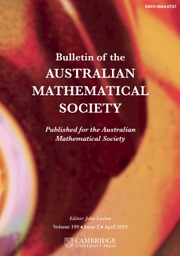Crossref Citations
This article has been cited by the following publications. This list is generated based on data provided by Crossref.
Paolucci, A.
and
Tsohantjis, I.
1997.
Hopf-type deformed oscillators, their quantum double and a q-deformed Calogero-Vasiliev algebra.
Physics Letters A,
Vol. 234,
Issue. 1,
p.
27.
McAnally, D S
and
Tsohantjis, I
1997.
Deformed boson algebras and the quantum double construction.
Journal of Physics A: Mathematical and General,
Vol. 30,
Issue. 2,
p.
651.
Goff, Christopher
2005.
An explicit fusion algebra isomorphism for twisted quantum doubles of finite groups.
Journal of Algebra,
Vol. 283,
Issue. 2,
p.
738.
Burton, P.J.
and
Gould, M.D.
2006.
Unitary R-matrices for topological quantum computing.
Reports on Mathematical Physics,
Vol. 57,
Issue. 1,
p.
89.
Dancer, K. A.
Isac, P. S.
and
Links, J.
2006.
Representations of the quantum doubles of finite group algebras and spectral parameter dependent solutions of the Yang–Baxter equation.
Journal of Mathematical Physics,
Vol. 47,
Issue. 10,
Dancer, K.A.
Finch, P.E.
Isaac, P.S.
and
Links, J.
2009.
Integrable boundary conditions for a non-Abelian anyon chain with D(D3) symmetry.
Nuclear Physics B,
Vol. 812,
Issue. 3,
p.
456.
Campbell, C.W.
Dancer, K.A.
Isaac, P.S.
and
Links, J.
2010.
Bethe ansatz solution of an integrable, non-Abelian anyon chain with D(D3) symmetry.
Nuclear Physics B,
Vol. 836,
Issue. 3,
p.
171.
Brennen, Gavin K.
Ellinas, Demosthenes
Kendon, Viv
Pachos, Jiannis K.
Tsohantjis, Ioannis
and
Wang, Zhenghan
2010.
Anyonic quantum walks.
Annals of Physics,
Vol. 325,
Issue. 3,
p.
664.
Finch, P E
2011.
Integrable Hamiltonians withD(Dn) symmetry from the Fateev–Zamolodchikov model.
Journal of Statistical Mechanics: Theory and Experiment,
Vol. 2011,
Issue. 04,
p.
P04012.
Finch, P.E.
Dancer, K.A.
Isaac, P.S.
and
Links, J.
2011.
Solutions of the Yang–Baxter equation: Descendants of the six-vertex model from the Drinfeld doubles of dihedral group algebras.
Nuclear Physics B,
Vol. 847,
Issue. 2,
p.
387.
Aguado, Miguel
2011.
From entanglement renormalisation to the disentanglement of quantum double models.
Annals of Physics,
Vol. 326,
Issue. 9,
p.
2444.
Links, Jon
2012.
Hopf Algebra Symmetries of an Integrable Hamiltonian for Anyonic Pairing.
Axioms,
Vol. 1,
Issue. 2,
p.
226.
Finch, Peter E
and
Frahm, Holger
2013.
TheD(D3)-anyon chain: integrable boundary conditions and excitation spectra.
New Journal of Physics,
Vol. 15,
Issue. 5,
p.
053035.
Krovi, Hari
and
Russell, Alexander
2015.
Quantum Fourier Transforms and the Complexity of Link Invariants for Quantum Doubles of Finite Groups.
Communications in Mathematical Physics,
Vol. 334,
Issue. 2,
p.
743.
Liu, Zhimin
and
Zhu, Shenglin
2019.
On the structure of irreducible Yetter-Drinfeld modules over quasi-triangular Hopf algebras.
Journal of Algebra,
Vol. 539,
Issue. ,
p.
339.
Cirac, J. Ignacio
Pérez-García, David
Schuch, Norbert
and
Verstraete, Frank
2021.
Matrix product states and projected entangled pair states: Concepts, symmetries, theorems.
Reviews of Modern Physics,
Vol. 93,
Issue. 4,
Génetay Johansen, Emil
and
Simula, Tapio
2022.
Prime number factorization using a spinor Bose–Einstein condensate-inspired topological quantum computer.
Quantum Information Processing,
Vol. 21,
Issue. 1,
Génetay Johansen, Emil
Vale, Chris
and
Simula, Tapio
2023.
Quantum double structure in cold atom superfluids.
AVS Quantum Science,
Vol. 5,
Issue. 3,
Liu, Zhimin
and
Zhu, Shenglin
2023.
Structures of adjoint-stable algebras over factorizable Hopf algebras.
Communications in Algebra,
Vol. 51,
Issue. 5,
p.
1800.
Génetay Johansen, Emil
and
Simula, Tapio
2023.
Topological quantum computation using analog gravitational holonomy and time dilation.
SciPost Physics Core,
Vol. 6,
Issue. 1,

